#Young’s Literal Translation of the Holy Bible
Text

Forgiveness
‘For, if ye may forgive men their trespasses He also will forgive you — your Father who [is] in the heavens; but if ye may not forgive men their trespasses, neither will your Father forgive your trespasses.
— Matthew 6:14-15 | Young's Literal Translation (YLT)
Young’s Literal Translation of the Holy Bible is in the public domain.
Cross References: Matthew 5:7; Matthew 7:2; Matthew 18:35; Mark 11:25; Luke 6:37; Ephesians 4:32; Colossians 3:13
#forgiveness#trespasses#God the Father#unforgiveness#Matthew 6:14-15#Gospel of Matthew#New Testament#YLT#Young’s Literal Translation of the Holy Bible
13 notes
·
View notes
Text
The Easter Bunny / Easter Hare
In German Easter tradition, the Easter Bunny is an imaginary rabbit or hare who paints eggs at Easter and hides them in the garden. Children search for Easter eggs on the morning of Easter Sunday. The motif of the Easter Bunny has recently spread in the popular culture of Easter, also through its commercial use, and has largely replaced earlier bringers of the Easter egg.

As far as is known, the Easter Bunny was first mentioned in the dissertation of the Frankfurt doctor Johannes Richier, who received his doctorate in 1682 under the respected Heidelberg professor of medicine Georg Franck von Franckenau with his treatise "De ovis paschalibus - von Oster-Eyern". The son of the pastor Jean Richier, who had fled France for religious reasons, describes a custom in Upper Germany, the Palatinate, Alsace and neighbouring regions, as well as Westphalia, according to which an Easter Bunny lays the eggs (ova excludere) and hides them in gardens in the grass, bushes, etc., where they are eagerly searched for by children amid laughter and to the amusement of the adults (cum risu et iucunditate seniorum). He calls the Easter Bunny hiding the eggs “a fable that is told to simpletons and children” (fabula, que simplicioribus et infantibus imponunt).
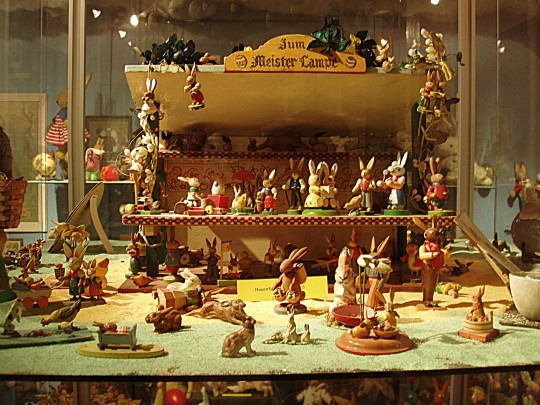
According to cultural studies, the reason for the strong upswing that belief in the Easter Bunny experienced in the 19th century can be found in the industrial production of cheap beet sugar, which made the production of affordable chocolate bunnies and eggs possible in the first place.

The connection between the Christian Easter festival and the egg as a symbol has been known in various European countries since the Middle Ages at the latest, and may even date back to earlier. There is also an older interpretation of the rabbit as a symbol of resurrection since Ambrose. The diverse Christian symbolism of the rabbit found expression in many works of art in the Middle Ages, see Rabbit in art. The connection between the rabbit and the Easter egg tradition is still unclear, however, even if the fertility of rabbits in itself has a close connection to spring. The following hypotheses are often put forward:
Some early painted Easter eggs show the three-hare image, a depiction of three hares with only three ears in total, but each hare having two ears due to the "double use" of ears; this is a well-known symbol for the Holy Trinity. It is possible that this depiction may have given rise to the idea of the hare as an egg supplier.
In one passage in the Bible, Psalm 104:18, older translations speak of "hares". The reason for this was the Latin translation of Proverbs 30:26, in which Jerome translated the Hebrew "schafan" (rock hyrax) as "lepusculus" (hare). Since late antiquity, this passage has been interpreted as a symbol for the weak human (hare) who seeks refuge in the rock (Christ). This interpretation established the symbolism of the hare in Christian iconography.
It is widely considered harmless to tell young children that the Easter Bunny brings eggs and sweets for Easter. Psychologists believe that this illusion stimulates the imagination and supports cognitive development. However, children's critical questions and doubts should be supported so that their belief in the Bunny eventually disappears by itself, also through interaction with other children.
The Easter Bunny was spread outside of Europe by German-speaking emigrants. It has gained a certain popularity in the USA in particular. In English, the term "Easter Bunny" predominates over the literal translation "Easter Hare", so the figure is often understood to be a rabbit.
In Australia, the "Easter Bilby" has been placed alongside the "Easter Bunny" since the 1970s. The aim is to draw attention to the endangered species of the greater burrowing bandicoot ("Bilby"), not least due to the spread of European rabbits, and to raise money for a conservation fund by selling chocolate bilbies.
137 notes
·
View notes
Note
hey wait a second. something's not adding up. in what universe do galahad and percival make out. what in hades.
OMGGG I FINALLY GET TO TALK ABOUT IT LETS GOOOOOOOOOOOOOOOOOO
Ok so
Percival and Galahad from arthurian legend do kiss in the Holy Grail quest! I worded it as making out as a joke, they don't make out-
BUT THEY DO KISS
It's meant to be a platonic kissy obvs similar to how in Kirby you kiss when healing but it does happen
The text is actually multiple, as there are so many versions of the grail quest itself
"When the two companions had tarried there until the hour of prime and had seen enough, they left and rode until they came to a forest.
Being about to enter it, Perceval said to Galahad: “To day we must separate and each go his own way. So I commend you to Our Lord’s keeping, and may He grant that we soon meet again. For I have never found a man whose company seemed so sweet and agreeable as yours; so this parting grieves me much more than you may suppose. Yet it must be so, since it pleases Our Lord.” When he removed his helmet, Galahad did the same, and they kissed at parting, for great was their love for one another: this appeared clearly in their death, for one barely survived the other."
The Quest of the Holy Grail W.W. Comfort's translation, page 220
You might find this kiss too in other more popular books such as Le Morte D'Arthur book XVII chapter XII
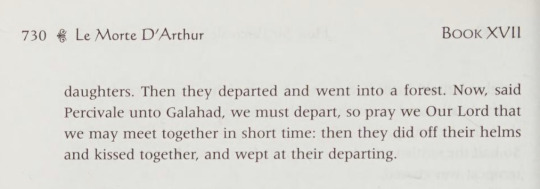
And there's other kiss later on in book XVII chapter XXII

If you pick up the physical book there might be a chance for the word to have been changed to "embrace", but some versions of it don't touch that word.
Ramble about the grail quest below, I finally have a perfect excuse to let out all my thoughts on the story and the grail knights hehehe
Percival and Galahad in general can switch to multiple dynamics based on authors, as arthurian legend is basically a bunch of people who inserted their knights ocs into this other story and then others recreated those oc's stories to make it cooler or fit in with those times. So Percival and Galahad can go from being the same person, friends, family and other things depending on what the author chooses. This applies to all characters in Arthurian Legend, there are no actual things set in stone. The canon is messy which is why sometimes u might see people hate a character but refer to it as "I hate Lanval's Guinevere" instead of the character as a whole because there are MULTIPLE versions of that character.
I'm gonna give a basic ramble about some of the story and show interactions I like between these two from multiple books after the ramble
HOWEVER I should warn and add a CW/TW that there's character death and implied su*cide (Galahad's death), the second one being more complicated due to how it's handled as Galahad wishes and asks for death and when it comes it's more of a "guys look he ascended he is now with Jesus Christ yippeee, what a cool act don't you wanna pray now" WHICH IS HMM KINDA BAD
I should also say that some parts of the Grial Quest are quite problematic as it puts down other religions and those who follow it as "sinners" or not worthy.
The grail has multiple interpretations as to why there has to be a quest for it, to spread religion, to heal the land and multiple others. Galahad is brought to the round table and does some cool stuff such as pulling out a sword from a stone similar to King Arthur and sitting on the Siege Perilous (a seat who kills anyone who sits there unless you are the chosen one). The Quest is related in some way to Joseph of Arimathea from the bible™ and in some interpretations the grail knights meet Jesus Christ himself. After achieving the grail Galahad asks God for death as he thinks he's lived long enough (he's like, VERY YOUNG??? AS IN HE IS KIND OF A LITERAL C H I L D??). Galahad seems to just inmediatly throw himself at objects that could kill him and is very careless which is kinda sad because even if he is supposed to be a character who we admire as God's knight he is also a kid who doesn't have the best parents and barely has friends, quite literally raised and born FOR the prophecy so it's no wonder he doesn't exactly know what to do after completing his "only purpose". I personally find the grail quest quite tragic, as I love Percival who's biggest dream was being a knight (he's also a babie™) and Galahad's death affects him enough to fully retire from it. Even if it's portrayed as him being "inspired" by Galahad's death enough to convert even more to religion. Not to mention he dies soon after anyways.
Now that u know some of it I can throw some interactions at full speed at you ohohoho SOME ARE ANGSTY OTHERS ARE CUTE AND FUNNY-





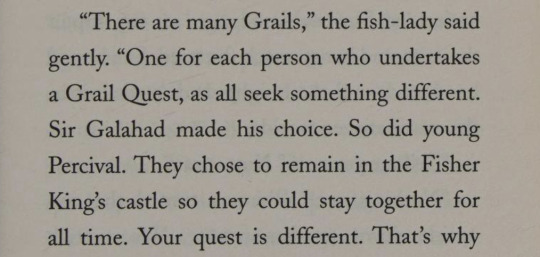


That's all tumblr is allowing me to show, also sorry Camachine for using your ask as an excuse to ramble about these two /lh. I'm big on Arthurian Legend and always wanted to ramble about it.
#I'm a bit flustered to post this ngl I'm not super used to rambling but I really adore these two sm so 👉👈#they are quite tragic imo but also THE GRAIL TEXT IS SO FREAKING BORING IM SO SORRY I DO NOT RECOMMEND IT IT'S B A D#I'm not sure if I should tag this as falsgato-#thanks for the ask!#michi's rambles#michi's askbox
16 notes
·
View notes
Text
the adventures of kid jesus, holy terror
(reposted from Twitter)
So I tend to think that the reason the four gospels that made it into the Christian Bible did so was because they were the ones that conflicted least with most of the major schools of early Christianity. Like, they don't preclude gnosticism, they don't really put Jesus in a particular political movement, etc. They're open to mystical interpretation, but they're among the least mystical of the candidates, etc.
They also involve relatively little Asshole Jesus.
But allow me to introduce you to the Infancy Gospel of Thomas.
No, not the Gospel of Thomas, the most famous of the noncanonical gospels.
The Infancy Gospel of Thomas.
The Infancy Gospel of Thomas was written before 185 CE, when Irenaeus was ranting about it, and after 80 CE, since it borrows from Luke and that's probably when Luke was written point being: as these things go, it's pretty old--this isn't medieval fanfic or whatevs. It was also very, very popular.
So.
The first thing baby Jesus does is make some clay sparrows on Shabbat which freaks everyone out in the way that only Jews written by Christians freak out, because he's 5 years old and 5-year-olds playing with mud on Shabbat is not, like, a big deal.
So anyway, Kid Jesus is there with another kid, who takes a stick and stirs a mud pool Kid Jesus made.
so Kid Jesus turns him into a mummy
The now-mummy kid's parents are understandably upset that their toddler got mummified for stirring some water with a stick and they go to complain to Joseph that his little holy terror of a son is desiccating people.
meanwhile, Kid Jesus is running around town
Another kid is running around town and bumps Kid Jesus's shoulder.
so Kid Jesus kills him
Joseph now has TWO sets of angry parents being like "my dude, your son is killing little kids which is profoundly Not Cool" so he goes to have a talk with Kid Jesus about how we don't just straight-up murder toddlers who bump into us.
Joseph sits Kid Jesus down and is like "look, son, we're being persecuted (translation: asked to stop) now because you're murdering children so maybe stop it?" and Kid Jesus says "aw, Dad, I know you don't mean it" and...
...Kid Jesus strikes the parents complaining that he's murdered their kids blind
Joseph twists his ear and Kid Jesus tells him to quit it and leave him alone to do his murdering in peace.
There's this teacher named Zacchaeus who for some reason is IMPRESSED by all this and is like, "your kid is so wise, my dude, let me teach him" and apparently he was okay at teaching the alphabet:
And he told him all the letters from Alpha even to Omega clearly.
Kid Jesus, on the other hand, is the worst student ever and is all:
thou hypocrite, first, if thou knowest it, teach the Alpha, and then will we believe thee concerning the Beta.
It's unclear whether he actually understands the definition of the term "hypocrite."
Zacchaeus, who's clearly a hardcore masochist, is all like:
Woe is me, wretch that I am, I am confounded: I have brought shame to myself by drawing to me this young child
And he's like "this 5-year-old who yelled at me about the order of the letters is CLEARLY an angel or a god."
No, I mean literally:
he is somewhat great, whether god or angel or what I should call him, I know not.
And Kid Jesus is like yup, I'm here to make you all miserable.
No, I mean literally:
I am come from above that I may curse them, and call them to the things that are above, even as he commanded which hath sent me for your sakes.
But Kid Jesus goes ahead and heals everyone he cursed, and after that, everyone's afraid to contradict him, because they are *literally terrified he will maim them.*
No, I mean literally:
And no man after that durst provoke him, lest he should curse him, and he should be maimed.
Then Kid Jesus and some other kids (I'm hesitant to characterize them as his friends) are playing in the upper story of a house and a kid falls out a window and dies so the dead kid's parents are like, "clearly this kid that's already straight-up murdered 2 other kids did it."
So Kid Jesus raises the other kid from the dead not because, you know, he's a little kid who fell out a window and died and that's tragic, or because his parents are grieving or whatever.
no, he raises him from the dead so the dead kid can back him up that he didn't murder him
Then Kid Jesus turns six and for a little while it seems like he's going to be less of a serial killer. He carries some water to his mom after the pitcher breaks, and uses his superpowers to help his dad with carpentry.
But then his dad decides that he's six so it's really time he learned his ABCs and now that he's a little older maybe he won't be so much of an asshole to his teachers so he gets a new teacher, and this one isn't as submissive as the last one.
Kid Jesus is an asshole to this teacher too, but this one smacks him upside the head for mouthing off.
so Kid Jesus kills him (or maybe just puts him in a coma)
Joseph is like maybe we just homeschool him.
But there's a teacher who's like PUT ME IN, COACH. And Joseph is like look my dude my murder-child has a 100% teacher-killing rate, are you sure? And the teacher's like I CAN DO IT.
Oh wait, Teacher #1 lived because he groveled, I forgot. Anyway, Teacher #3 also grovels, which pleases Kid Jesus so much that he heals/resurrects Teacher #2.
So then Kid Jesus's brother James gets bitten by a snake and Jesus heals him which is nice I guess but James best thank him thoroughly or he might get murdered like every other kid in the village.
And then a baby gets sick and dies and Kid Jesus resurrects him and the villagers are like: "Of a truth this young child is either a god or an angel of God; for every word of his is a perfect work."
because they have the world's shortest memories
So a guy dies and Kid Jesus resurrects him and they're all:
This young child is from heaven: for he hath saved many souls from death, and hath power to save them all his life long.
which IGNORES THAT MOST OF THE PEOPLE HE RESURRECTED WERE DEAD IN THE FIRST PLACE BECAUSE HE KILLED THEM
And then there's a paragraph about him teaching in the Temple when he was 12 that's very similar to the one in Luke and that's a wrap.
Behold: the Infancy Gospel of Thomas
and this shit was apparently VERY POPULAR
So yeah, one of the more popular early Christian bestsellers was, just to sum up: Jesus murders a bunch of people, maims anyone who objects, brings them back to life, and everyone who witnesses it thinks that everything he does is perfect after he terrifies them into submission.
#early christianity#infancy gospel of thomas#noncanonical gospels#jesus the serial killer#yes everyone I'm aware this is also the plot of a Twilight Zone episode
28 notes
·
View notes
Text
A Praying Church
Acts 1:1–14. They all joined together constantly in prayer. (v. 14)
As a young Christian, I took Jesus’ admonition in Matthew 6:6 to pray in secret literally. But the translation of the Bible I read at the time was the King James Version, which said, “enter into thy closet and when thou hast shut thy door, pray to thy Father which is in secret.” I took that literally so I went into my bedroom, climbed into my messy closet, and prayed in the dark!
However, Jesus’ teaching did not forbid public prayer. The plural wording of the Lord’s Prayer (“our Father,” “our daily bread,” “our debts”) implies corporate prayer (Matt. 6:9, 11, 12). After His resurrection, Jesus told the disciples not to leave Jerusalem but to wait for the promised Holy Spirit (v. 4). Verse 14 tells us how Jesus’ followers occupied themselves during this waiting period when it says that they “all joined together constantly in prayer.”
Although we do not have a record of what they prayed for, Luke provides two important details. Believers not only prayed in private but also prayed publicly together. The fact that they “joined together” shows that this was corporate prayer. Luke also implies that the disciples did this over a prolonged period when he says they prayed “constantly.” Perhaps the disciples attended regularly scheduled prayer services at temple during this waiting period. But they also met for prayer in the upstairs room of the home where they were staying (v. 13). There were no church buildings to meet in at that time.
Corporate prayer builds church unity and helps its members get to know one another. It is also a good way to teach believers how to pray. Sometimes, the difficulty with corporate prayer is that we often get distracted, wondering how our prayers sound to others. Our focus should be on God, even when others are listening. If you feel nervous about praying in public, you might begin by listening and agreeing silently as others pray aloud.
#devotional#god#jesus#christ#holy spirit#bible#scripture#christianity#faith#ministry#prayer#praise#worship#love#Christian#grace#daily devotional#daily devotion
23 notes
·
View notes
Text
to be befriended like this may take a whole lifetime
(and more)
to see the gentleness of a written seed reach deep into (the inner garden and the inner room) of another to first cross paths in the silence of the instrumental womb
but i’ll never regret all the standing this takes, and all the patient time in growing in pages and in annual rings
because it all points to something that will never end… life in the eternal
where it will always be [here, & now]
“timelessness”
A new transformed body to match the reborn human heart & spirit, remade in the divine image of the Son
(A new Adam & Eve)
it is (A True : Love story) of [metamorphosis : 8]
of being made (inside, Anew)
through the Body (the bread of the Word) & the Blood (as wine freely offered to a friend)
just as this glass is seen (transparently) in written words on an illuminated screen, originating from the growth of the Vine
tending to this (and watering it) has indeed taken some time.
in all my labor, my “work” here on garden earth
my True “calling” in life.
A story read during Passover
(from Today’s email sent by Israel365)
Song of Songs, read on the holiday of Passover, is written as a love story between a woman and her beloved. It describes a romantic relationship, often using very sensual language. At first glance, it seems like such a book has no place among the other books of the Bible. The Bible is holy, the love between man and woman is earthly and mundane. The book’s language portrays a passionate and intense love, which seems out of place in a religious text.
Indeed, some translations prefer not to translate Song of Songs with a literal translation, opting to forgo the simple meaning of the text and providing an allegorical interpretation instead. Since the literal language of the text is too physical, they provide their readers with only the “deeper” meaning of King Solomon’s words.
This, of course, begs the question of why Song of Songs was written as a love story at all.
The question becomes even stronger when you consider the words of the great Talmudic sage, Rabbi Akiva, who said:
“The entire universe is unworthy of the day that the Song of Songs was given to Israel, for all the Writings are holy, but Song of Songs is the Holy of Holies. ” (Mishna Yadayim 3:5)
Does this love story really sound like the “Holy of Holies? Was the whole world created for this?
We will answer these questions with another question, a question asked by Rabbi Chanoch Henoch of Alexander, a student of the Hassidic Rabbi Menachem Mendel of Kotzk (1787-1859). The seder is a special meal that is eaten on Passover night. During this meal, the Exodus from Egpyt is discussed in question-and-answer format, beginning with four specific questions. Yet we don’t start the seder immediately with these four questions. If the point of the seder is to discuss the Exodus and ask these questions, why do we do a few other things first?
In order to answer this question, let’s imagine the following scenario. A couple has been dating for some time and things have been going well. They are sitting in a romantic spot when the man takes a deep breath and says to the woman: “I love you – will you marry me?” Assuming this young lady feels the same way that he does, how should she respond at this moment? Should she dive into: “But how will we support ourselves?” or “What will our families think?” These aren’t bad questions, they’re important questions! But the fact is that these questions don’t really belong at that moment. Because it is a formative moment, a sacred moment, and a moment that transcends all questions.
Passover, when God took our forefathers out of Egypt, was a formative moment; it was the engagement of our entire people to God. The story of Passover is something that goes beyond the intellect. It is a reliving of that moment of engagement, that moment that every couple will remember for the rest of their lives. First and foremost, Passover is about those extraordinary raw and powerful moments that we, every last one of our people, shared with God at that time.
We don’t begin the seder with the four questions because not everything is open to question. It is only after we speak about the uniquely close and loving relationship that we as a people have with God that we can begin to ask questions. If we would start with questions right away, we would be missing something very deep, something so essential. Because a relationship, a relationship of real love that runs deeper than the mind, doesn’t begin with logical questions.
This is what King Solomon was describing in Song of Songs, and this is what makes the book so unusual and so spectacular. Song of Songs is about the love between God and His people. It is about those moments that come before questions! Song of Songs is not about religion; it is about God Himself!
I believe that this is why Song of Songs is considered “Holy of Holies.” Religion is holy, observing the Sabbath is holy, and the Temple is holy. But there is something that goes beyond holy, and that is our relationship with God Himself. This is also why Song of Songs is read on Passover, because it was on Passover that the love story between God and his people began.






do you see that “i love you” (already inside) A pure “seed” (to be…)?
0 notes
Text

Hey Negro, Stop Calling Yourselves Christians
Many years ago, like most of you who consider yourselves Christians, I believed that, obviously -- or so it appeared, this religion advocated "The Way" or "Road Map" that Yeshuah (in English, Joshua) taught in the New Testament, and that Christianity was a religion all about life and love and compassion and fellowship, suffering, overcoming, and faith in God.
I suppose my innocent belief and the love for Yeshuah that inspired me, was rooted in the same tradition as the popular Passion Play musical, "Godspell" --which I still love for the music and sentiment, but now view with a far more mature and jaundiced perspective.
To make this an example, doesn't it give you pause to look at the name, "Godspell" --- as in "God's spell" as in a spell of witchcraft? Spell-binding? Why call it that, if that's not what it is?
Remember that the Liars are required to declare the Truth of what they are doing.
In later years, I came to know that all "Christians" take a "Blood Oath" though I never recognized it as such when I was a young man.
The Pastors of the Evangelical Lutheran Church that I attended faithfully and took seriously as a teenager and young adult certainly never breathed a word of any such thing, but having studied Law and History and Religion for five decades, I know what they didn't tell me.
The Blood Oath is the Apostle's Creed, and the blood is the Communion wine. Simple as that.
You've been asking me about my "Blood Oath", but what you need to worry about is your own.
In reviewing the Catholic Doctrine of Transubstantiation, which teaches that the Communion wine mysteriously becomes actual blood in the cup, and the implications of cannibalism this carries with it, I became truly alarmed.
And I started investigating, just as I did when I went to the IRS Office for answers and was told that the workers couldn't affirm the answers they'd given me.
One of the other things that initially raised my eyebrows and sent my Shinola Sensor off-scale was the fact that The Holy Bible is a copyrighted work of the Roman Catholic Church.
This implies that they literally wrote it as a unique work of art and they claim authorship, as their work, and not a compendium of ancient manuscripts brought together and compiled and "approved" as genuine by Catholic scholars and theologians.
No, they claim authorship, which is quite a different matter.
And that was a shock.
I had to think -- and you should, too -- I am committing my life and soul and money and time to a novel written by the Roman Catholic Church?
A novel which is periodically revisited every fifty years and changed -- just enough -- to earn a new copyright? Really?
And yet, further investigation yields that this is exactly true, and timed out that way, too. Every fifty years like clockwork, a new version is released and a new copyright is obtained.
All the various other renditions and translations of The Bible from the King's James Version to the NIV and even the Jehovah Witnesses' rendition, all do the same thing.
They all claim to be copyrighted works of art.
Works of art. Like a play. Like Georgette Heyer. Like David Copperfield or Moby Dick.
Let that sink in.
Then, I started thinking--- his name was Yeshuah and that translates directly as Joshua in English, so why is everyone calling him "Jesus"?
That doesn't even make sense.
Saint Jerome knew this as well as I do.
So why change his name? Just for the sake of obfuscation? To hide the fact that he was Jewish?
Or to make him into someone else?
The more I thought about this and delved into it, the tighter the little knot of wrinkles at the bridge of my nose got.
And then, there's the rest of the name they attached to him posthumously, "Christ".
Christ means "the Anointed One" -- and it is an office of priesthood -- the priesthood of Baal.
Okay, take a deep breath and go back and read the last several books of the Gospels. What do you see now that you didn't see before?
According to the narrative, when the Jews rejected him, Yeshuah turned to the Gentiles and Samaritans instead, and accepted being anointed as a priest of Baal by Mary Magdalene.
So, Jesus Christ isn't Yeshuah.
It's another Substitution Scheme.
And the religion you have been depending on for your moral guidance and ethical inspiration and eternal salvation is just another shell game.
Like Gollum, the purveyors of Christianity have served an unintended purpose, and have preserved and popularized the teachings of Yeshuah (many of which were borrowed from earlier teachers and wisdom traditions) and that has had an amazing and transformative effect on our lives -- for the better.
Yet, the downsides have to be admitted, too --- fear, coercion, superstition, religious prejudice and elitism, not to mention innumerable acts of cruelty, murder, and theft and fraud which have been excused in the name of different religious beliefs.
And then, the final straw was discovering that they were using baptism as an excuse to claim an ownership interest in the Nephesh, the part of a living soul that gives us animal energy and the ability to perform labor.
They have been buying, selling, trading, and monetizing the value of this part of our soul and used baptismal certificates to do it -- and have been creating labor bonds to harvest this venal undisclosed claim upon the value of our labor.
They've claimed that your innocent acceptance of "Christian" baptism gives them an ownership interest in the Nephesh part of your soul, and a private contract claim on the value of your labor --- and never a whisper to you about this.
This is the private "contract" that the Internal Revenue Service / IRS is enforcing.
To which I said, eff them forever, the dirty, rotten, lying, sneak-thief bastards. Enslaving people and condemning them to lifelong peonage, behind the face of a "purifying sacrament"!
I'll purify them, and when I am done, they will be lucky to have any skin left.
I meant it, too, from the bottom of my soul.
The Ruach, God's Breath within me, affirmed my complete, utter, unrelenting disgust with them and what they have done "in the name of God".
So I wrote the Evangelical Lutheran Church in Black River Falls, Wisconsin, a nice succinct letter, told them what they were engaged in, and instructed them in no uncertain terms to strike my name off their baptismal enrollment register -- for lack of disclosure.
And damn you, very much.
I don't consider myself a "Christian", and it has nothing to do with my love for Joshua or his teachings, which remains.
It has to do with what the word "Christian" really means and the practices these Liars have employed to mislead, rob, and abuse generations of innocent people who relied on them for truth, comfort, protection, and solace.
I'll go toe to toe with the phony "Pope" Francis or the Eastern Patriarch or the Archbishop of Canterbury any day they want to face me --- but they won't want to face me.
In their tradition, they will be staring into the face of the Primal Creator, Durga, the Great Mother, come now to reap their souls for their iniquity -- and take away all their unjust enrichment, too.
So don't expect any chummy ecumenical councils from me. Expect me to drive them like so many foxes before the hounds.
My advice to you, good Christians all -- stop calling yourselves "Christians" when that doesn't mean what you think it means, stop relying on these evil, selfish, venal men for anything but a nose-bleed.
They don't know God. They don't know Joshua or his teachings in their hearts. Most of them don't even know what their own churches have been doing.
Stop taking Blood Oaths substituted for any kind of true Communion and submitting to their filthy excuse for a Baptism.
Look within yourselves for the Truth and the Way and the Life, and make your own quiet Communion with your Lord whenever you drink wine or eat bread.
Bless it in his true name--Joshua, and pray in his true name, too. Then step back and see what miracles come to you.
Proof is in the pudding, dear hearts.
Just as it was in the days of Elijah and Ezekial, you shall see what you shall see.
0 notes
Text
Which Bible is Right for you?
AMP-The Amplified Bible is an English language translation of the Bible produced jointly by Zondervan and The Lockman Foundation. The first edition was published in 1965. It is largely a revision of the American Standard Version of 1901, with reference made to various texts in the original languages.

KJV - King James Version - A great Bible for all to own. Written in Old English, typically hard to understand. Printed in 1611 it was a collaborative effort of 47 scholars. Widely accepted as an accurate translation, yet difficult in todays terms to understand however the difficulty of this one is a must-get!

NKJV - New King James Version - A great study Bible. This one is for anyone who finds the 1611 KJV way too difficult to read or understand. The NKJV is written in a mix of old and new English. So for the everyday reader, it is a great one to read and also a must-get!

NIV - New International Version - Common Bible Study Translation, easy and relevant reading, It has sold way over a million copies however it is missing certain key scriptures. I strongly advise against this Bible as while it may be really easy to understand. It is known as a "thought for thought" translation.

ESV-The English Standard Version is an English translation of the Bible. It was first published in 2001 by Crossway. The ESV is based on the 1971 edition of the Revised Standard Version text.

NASB - New American Standard Bible - Common Bible Study Translation, readable and known for accuracy. It pays close particular attention to the verbs in order to give the reader the same sensitivity to passages being read in the Greek, Aramaic, or Hebrew forms. Highly literal version. ESV - English Standard Version - Common Bible Study Translation, easy to read and known for accuracy. Known as a "word-for-word" translation. It is the most translated into the most accurate English word of this time.
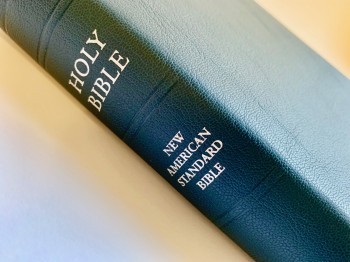
NLT - New Living Translation - Good Bible study version. One of the easiest to read and translated into the current language. I personally find it very easy to understand it is known worldwide for accuracy but it's not recommended alone because of the non-word-for-word translation.

The following Bible versions I DO NOT recommend for accuracy but are widely read for reasons of delivering a message to a specific age group including teens and young adults. Not to be used for study, memorisation, or preaching without other versions included.
NIV- The New International Version is an English translation of the Bible first published in 1978 by Biblica. The NIV was published to meet the need for a modern translation done by Bible scholars using the earliest, highest-quality manuscripts available. I personally call it the politically correct Bible.
The Message - Dynamic version with very modern English. Paraphrases without complete accuracy to verbs, or literal translations. I do not recommend it as it is way too simplified and does not have enough depth.

LB - The Living Bible - Modern English, not recommended. Paraphrased and considered inadequate. Known as more of a commentary than an accurate translation of the Bible.
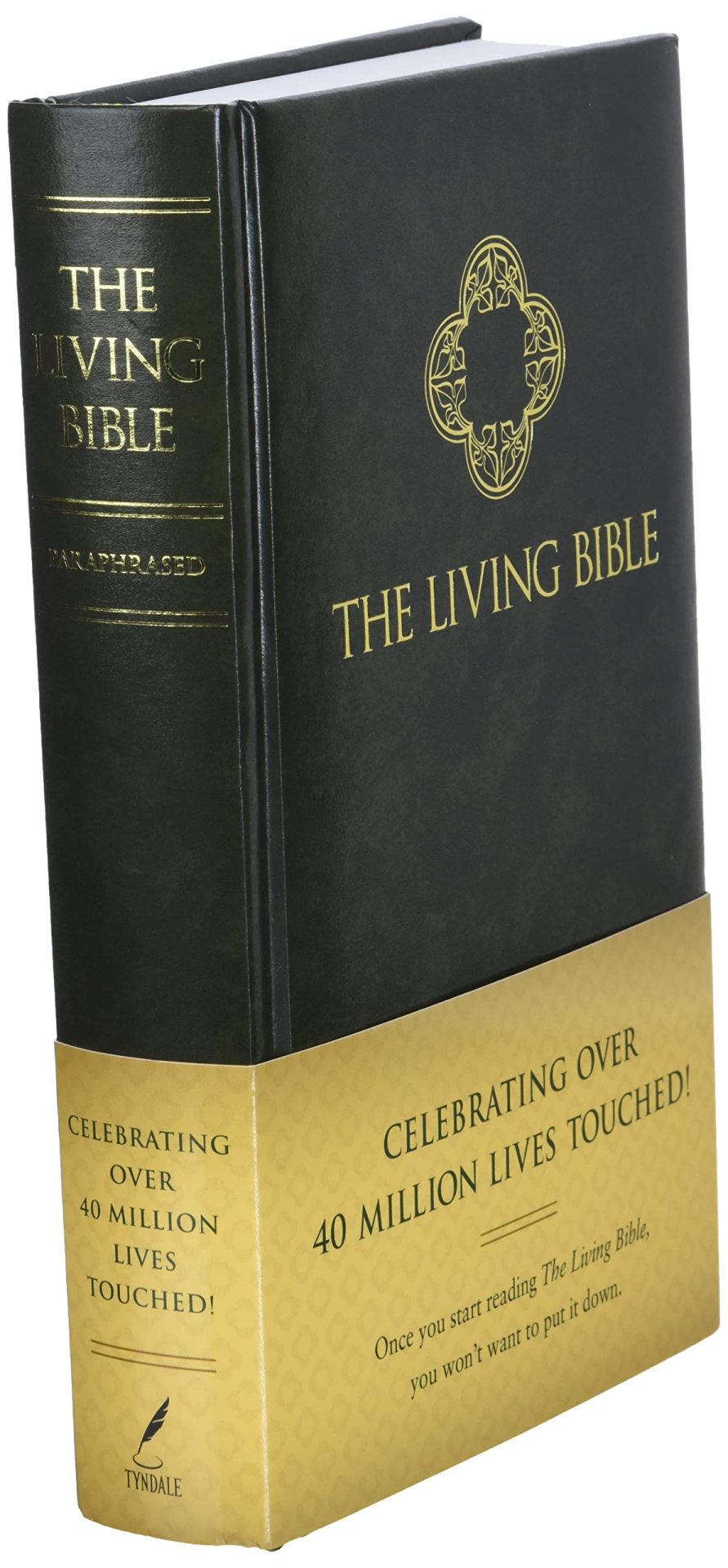
Thoughtfully consider purchasing a Bible that is easy for you to read. You are then more likely to spend time reading it. A large type is helpful, as well as margins that are large enough to add notes. There are also a number of additions in certain Bibles with maps, a cross-reference system, concordance and a dictionary. These tools are necessary for any serious study of the Holy Bible. I own a KJV, NKJV, NLT, and ESV. I mostly read the ESV or the KJV.
#biblefacts#bible study#bible verse#bible prophecy#christian#god#scripture#bible review#faith#holy bible#jesuslovesyou#jesus#bible quote#truth#christianity#christian blog#bible reading#bibledaily#bible notes#biblical#gospel#faith in god
1 note
·
View note
Text
Kenneth hagin healing how to receive it and keep it

Kenneth hagin healing how to receive it and keep it free#
After the end of all things, Satan will be put in the lake of fire and brimstone (Rev. Christ came to destroy "him that had the power of death." Satan isn't destroyed yet, but he will be put in the bottomless pit for a thousand years after Jesus returns.
Kenneth hagin healing how to receive it and keep it free#
Romans 8:2 says, "For the law of the Spirit of life in Christ Jesus hath made me free from the law of sin and death." We have the promise that when Jesus comes again, this last enemy shall be put underfoot. The law of the spirit of life in Christ Jesus is God's law. The law of sin and death is the devil's law. Where does death come from, then? It comes from Satan, who has the power of death: HEBREWS 2:14 14 Forasmuch then as the children are partakers of flesh and blood, he also himself likewise took part of the same that through death he might destroy him that had the power of death, that is, the devil. Does death come from God? No, He is not the author ofĭeath He's the author of life. Death has never entered there, and it will never enter there. Where does death come from? Does it come from heaven? Are there any dead in heaven? The answer, of course, is no. Only then was Pharaoh compelled to yield and let the children of Israel go. When the final plague, the messenger of hell-death- was permitted, death went forth and destroyed the firstborn of every Egyptian household. But when Pharaoh hardened his heart, God withdrew His protecting hand and permitted the plagues to sweep over the land of Egypt. God did not send plagues to come upon the Egyptian people. Nowhere in the New Testament do we find God putting sickness on anyone! Remember, when God commanded Moses to go down into Egypt and lead the children out of Egyptian bondage, He sent Moses to plead with Pharaoh to release the people. We must bear in mind the Scripture in Acts 10:38, "How God anointed Jesus of Nazareth with the Holy Ghost and with power: who went about doing good, and healing all that were oppressed of the devil for God was with him." This important Scripture shows that Jesus is the Healer Satan the oppressor. Young says that in Exodus 15:26, the literal Hebrew reads, "I will permit to be put upon thee none of the diseases which I have permitted to be brought upon the Egyptians, for I am the Lord that healeth thee." Some think God made Job sick. Although this book is no longer in print, I made notes from it many years ago. Robert Young, the author of Young's Analytical Concordance to the Bible, and an outstanding Hebrew scholar, points this out in his book Hints and Helps to Bible Interpretation. Verb in the Hebrew has been translated in the causative sense when it should have been translated in the permissive sense. The key to these difficulties lies in the fact that the active 5 He only permits it to come as a result of man's disobedience. God permitted it to come, but He didn't create it. Evil could not come from heaven, because there is no evil there. God only permits evil He doesn't create it. " Similar Scriptures are Isaiah 45:7, "I form the light, and create darkness: I make peace, and create evil: I the Lord do all these things" and Micah 1:12, "For the inhabitant of Maroth waited carefully for good: but evil came down from the Lord unto the gate of Jerusalem." Obviously, these passages in the King James Version of the Bible do not give the true meaning of the original Hebrew, for we know that God doesn't create evil. I will put none of these diseases upon thee, which I have brought upon the Egyptians: for I am the Lord that healeth thee. Those who say this usually quote Exodus 15:26, "If thou wilt diligently hearken to the voice of the Lord thy God, and wilt do that which is right in his sight. 1: "God sends sickness upon people." Some have said that the Old Testament declares that God sent sickness on people. In order to remove some of these obstacles that hinder believers from receiving divine healing, let us examine some of the more common roadblocks. Still others are based on misquoted and misunderstood Scriptures. Some have their basis in tradition others in superstition. These roadblocks wear many subtle disguises and come from many sources. More often than not it is strewn with roadblocks placed in our way by the devil to keep God's people from the blessing of health which God has provided. The road to divine healing is seldom an expressway. Patent and Trademark Office and therefore may not be duplicated.Ĭontents 1 Roadblocks to Healing. The Faith Shield is a trademark of RHEMA Bible Church, aka Kenneth Hagin Ministries, Inc., registered with the U.S. Box 335, Station D Etobicoke, Ontario Canada, M9A 4X3Ĭopyright © 1983 RHEMA Bible Church AKA Kenneth Hagin Ministries, Inc. In Canada write: Kenneth Hagin Ministries P.O. Hagin Second Edition Fourteenth Printing 1995 ISBN 0-89276-008-7 In the U.S.

0 notes
Text
The Dangers of Demonic Impartation & Spiritual Transfer
Impartations can be godly or demonic.
Impartation is both a scriptural concept and a spiritual reality. Impartation is a divine transfer that releases an ability you didn’t have before. Through impartation, the Holy Spirit gives or grants you a spiritual gift, revelation, or power that you need to fulfill your purpose. Paul told the church in Rome:
For I am yearning to see you, that I may impart and share with you some spiritual gift to strengthen and establish you; that is, that we may be mutually strengthened and encouraged and comforted by each other’s faith, both yours and mine (Romans 1:11-12 AMPC).
Impart in this context simply means “impart” or “give.” It means to grant as from a store. God has a great storehouse of gifts and He wants to impart what will strengthen you in your calling. Young’s Literal Bible translates this “to give a share of.” We can receive impartation from God Himself or from anointed men and women through the laying on of hands, through applying oil, by sitting under a teaching anointing (which is why it’s so dangerous to sit under erroneous teaching), or directly from God.
/*<![CDATA[*/ (function () { var scriptURL = 'https://sdks.shopifycdn.com/buy-button/latest/buy-button-storefront.min.js'; if (window.ShopifyBuy) { if (window.ShopifyBuy.UI) { ShopifyBuyInit(); } else { loadScript(); } } else { loadScript(); } function loadScript() { var script = document.createElement('script'); script.async = true; script.src = scriptURL; (document.getElementsByTagName('head')[0] || document.getElementsByTagName('body')[0]).appendChild(script); script.onload = ShopifyBuyInit; } function ShopifyBuyInit() { var client = ShopifyBuy.buildClient({ domain: 'nori-media-group.myshopify.com', storefrontAccessToken: 'd4019987e189be3ec0cf97ea37531adb', }); ShopifyBuy.UI.onReady(client).then(function (ui) { ui.createComponent('product', { id: '4777233186902', node: document.getElementById('product-component-1658433611830'), moneyFormat: '%24%7B%7Bamount%7D%7D', options: { "product": { "styles": { "product": { "@media (min-width: 601px)": { "max-width": "calc(25% - 20px)", "margin-left": "20px", "margin-bottom": "50px" } }, "title": { "font-family": "Roboto, sans-serif", "color": "#000000" }, "button": { "font-family": "Droid Sans, sans-serif", "font-weight": "bold", ":hover": { "background-color": "#d87a35" }, "background-color": "#f0873b", ":focus": { "background-color": "#d87a35" }, "border-radius": "25px", "padding-left": "26px", "padding-right": "26px" }, "price": { "font-family": "Roboto, sans-serif", "color": "#444444" }, "compareAt": { "font-family": "Roboto, sans-serif", "color": "#444444" }, "unitPrice": { "font-family": "Roboto, sans-serif", "color": "#444444" }, "description": { "font-family": "Roboto, sans-serif" } }, "contents": { "button": false, "buttonWithQuantity": true }, "text": { "button": "Add to cart" }, "googleFonts": [ "Roboto", "Droid Sans" ] }, "productSet": { "styles": { "products": { "@media (min-width: 601px)": { "margin-left": "-20px" } } } }, "modalProduct": { "contents": { "img": false, "imgWithCarousel": true, "button": false, "buttonWithQuantity": true }, "styles": { "product": { "@media (min-width: 601px)": { "max-width": "100%", "margin-left": "0px", "margin-bottom": "0px" } }, "button": { "font-family": "Droid Sans, sans-serif", "font-weight": "bold", ":hover": { "background-color": "#d87a35" }, "background-color": "#f0873b", ":focus": { "background-color": "#d87a35" }, "border-radius": "25px", "padding-left": "26px", "padding-right": "26px" }, "title": { "font-family": "Roboto, sans-serif", "font-weight": "bold", "font-size": "26px", "color": "#4c4c4c" }, "price": { "font-family": "Roboto, sans-serif", "font-weight": "normal", "font-size": "18px", "color": "#4c4c4c" }, "compareAt": { "font-family": "Roboto, sans-serif", "font-weight": "normal", "font-size": "15.299999999999999px", "color": "#4c4c4c" }, "unitPrice": { "font-family": "Roboto, sans-serif", "font-weight": "normal", "font-size": "15.299999999999999px", "color": "#4c4c4c" }, "description": { "font-family": "Roboto, sans-serif", "font-weight": "normal", "font-size": "14px", "color": "#4c4c4c" } }, "googleFonts": [ "Roboto", "Droid Sans" ] }, "option": { "styles": { "label": { "font-family": "Roboto, sans-serif" }, "select": { "font-family": "Roboto, sans-serif" } }, "googleFonts": [ "Roboto" ] }, "cart": { "styles": { "button": { "font-family": "Droid Sans, sans-serif", "font-weight": "bold", ":hover": { "background-color": "#d87a35" }, "background-color": "#f0873b", ":focus": { "background-color": "#d87a35" }, "border-radius": "25px" }, "title": { "color": "#4c4c4c" }, "header": { "color": "#4c4c4c" }, "lineItems": { "color": "#4c4c4c" }, "subtotalText": { "color": "#4c4c4c" }, "subtotal": { "color": "#4c4c4c" }, "notice": { "color": "#4c4c4c" }, "currency": { "color": "#4c4c4c" }, "close": { "color": "#4c4c4c", ":hover": { "color": "#4c4c4c" } }, "empty": { "color": "#4c4c4c" }, "noteDescription": { "color": "#4c4c4c" }, "discountText": { "color": "#4c4c4c" }, "discountIcon": { "fill": "#4c4c4c" }, "discountAmount": { "color": "#4c4c4c" } }, "text": { "title": "Checkout powered by Faith & Flame" }, "googleFonts": [ "Droid Sans" ] }, "toggle": { "styles": { "toggle": { "font-family": "Droid Sans, sans-serif", "font-weight": "bold", "background-color": "#f0873b", ":hover": { "background-color": "#d87a35" }, ":focus": { "background-color": "#d87a35" } } }, "googleFonts": [ "Droid Sans" ] }, "lineItem": { "styles": { "variantTitle": { "color": "#4c4c4c" }, "title": { "color": "#4c4c4c" }, "price": { "color": "#4c4c4c" }, "fullPrice": { "color": "#4c4c4c" }, "discount": { "color": "#4c4c4c" }, "discountIcon": { "fill": "#4c4c4c" }, "quantity": { "color": "#4c4c4c" }, "quantityIncrement": { "color": "#4c4c4c", "border-color": "#4c4c4c" }, "quantityDecrement": { "color": "#4c4c4c", "border-color": "#4c4c4c" }, "quantityInput": { "color": "#4c4c4c", "border-color": "#4c4c4c" } } } }, }); }); } })(); /*]]>*/
Genesis 28:1-4 reveals we can receive blessings through impartation:
Then Isaac called Jacob and blessed him. Then he charged him and said to him, “You must not take a wife of the daughters of Canaan. Arise, go to Paddan Aram to the house of Bethuel your mother’s father, and take for yourself a wife from there, from the daughters of Laban your mother’s brother. May God Almighty bless you and make you fruitful and multiply you, so that you may become a multitude of people. May He give you the blessing of Abraham, to you and your descendants with you, that you may inherit the land where you are a stranger, which God gave to Abraham” (MEV).
If you can receive a blessing through impartation of laying on of hands, doesn’t it make sense you can receive a curse? The enemy is looking for a point of contact. I have known on-fire Christians who came in contact with witches who took a strand of their hair and they wound up with bald spots and blemishes all over their body. Be careful who you allow to lay hands on you.
Acts 8:14-17 shows how we can receive an impartation of the Holy Spirit through the laying on of hands:
Now when the apostles who were at Jerusalem heard that Samaria had received the word of God, they sent Peter and John to them. When they came down, they prayed for them that they might receive the Holy Spirit, for still He had come on none of them. They were only baptized in the name of the Lord Jesus. Then they laid their hands on them, and they received the Holy Spirit (MEV).
If we can receive the Holy Spirit through laying on of hands, don’t you think we can receive some other spirit—a demonic spirit—through the laying on of hands? Be careful who you allow to lay hands on you.
First Timothy 4:14 shows how we can receive spiritual gifts by the laying on of hands: “Do not neglect the gift that is in you, which was given to you by prophecy, with the laying on of hands by the elders” (MEV). If we can receive Holy Spirit gifts through prophecy and the laying on of hands, don’t you think we can receive divination and false anointings through the laying on of hands? Be careful who you allow to lay hands on you.
Luke 4:40 demonstrates how we can receive healing through the laying on of hands: “Now when the sun was setting, all those who had anyone sick with various diseases brought them to Him. And He laid His hands on every one of them and healed them.” If we can receive healing through a point of contact, don’t you think we can receive the spirit of infirmity through a point of contact? Be careful who you allow to lay hands on you.
Can Spirits Really Transfer?
Yes, demon spirits really can transfer from one person to another. You can’t catch a demon the way you would catch a cold or flu, but you can walk into a meeting completely free and walk out demonized and not even know it. Although we have authority over demons, when we enter into situations where the Holy Spirit did not lead and allow a demonized person to lay hands on us or spray miracle water into our eyes, we have given permission for demons to enter.
And, again, willfully sitting under someone who is teaching by the influence of the spirit of error can open you up to a spirit of error. I have been warned not to sit under the teaching of certain leaders in the Body of Christ because they are walking in heresy and a spirit of error marks their ministry. Although much of their teaching is good, that spirit of error is still lurking. The Bible actually speaks of the spirit of error in First John 4:6: “We are of God. He who knows God hears us; he who is not of God does not hear us. By this we know the spirit of truth and the spirit of error.”
I have also been warned not to associate or align with certain leaders for the same reason. We are not to be unequally yoked (see 2 Cor. 6:14). While this Scripture is generally spoken over people who want to marry or start business partnerships with unbelievers, you can also be unequally yoked with believers. You can receive demonic impartations through error you read in books, amulets people give you, and other ways. The reality is clear: Demons can transfer from one person to another in many ways. Be careful who you let lay hands on you.
/*<![CDATA[*/ (function () { var scriptURL = 'https://sdks.shopifycdn.com/buy-button/latest/buy-button-storefront.min.js'; if (window.ShopifyBuy) { if (window.ShopifyBuy.UI) { ShopifyBuyInit(); } else { loadScript(); } } else { loadScript(); } function loadScript() { var script = document.createElement('script'); script.async = true; script.src = scriptURL; (document.getElementsByTagName('head')[0] || document.getElementsByTagName('body')[0]).appendChild(script); script.onload = ShopifyBuyInit; } function ShopifyBuyInit() { var client = ShopifyBuy.buildClient({ domain: 'nori-media-group.myshopify.com', storefrontAccessToken: 'd4019987e189be3ec0cf97ea37531adb', }); ShopifyBuy.UI.onReady(client).then(function (ui) { ui.createComponent('product', { id: '4777233186902', node: document.getElementById('product-component-1658433591271'), moneyFormat: '%24%7B%7Bamount%7D%7D', options: { "product": { "styles": { "product": { "@media (min-width: 601px)": { "max-width": "100%", "margin-left": "0", "margin-bottom": "50px" }, "text-align": "left" }, "title": { "font-family": "Roboto, sans-serif", "font-size": "26px", "color": "#000000" }, "button": { "font-family": "Droid Sans, sans-serif", "font-weight": "bold", ":hover": { "background-color": "#d87a35" }, "background-color": "#f0873b", ":focus": { "background-color": "#d87a35" }, "border-radius": "25px", "padding-left": "26px", "padding-right": "26px" }, "price": { "font-family": "Roboto, sans-serif", "font-size": "18px", "color": "#444444" }, "compareAt": { "font-family": "Roboto, sans-serif", "font-size": "15.299999999999999px", "color": "#444444" }, "unitPrice": { "font-family": "Roboto, sans-serif", "font-size": "15.299999999999999px", "color": "#444444" }, "description": { "font-family": "Roboto, sans-serif" } }, "layout": "horizontal", "contents": { "img": false, "imgWithCarousel": true, "button": false, "buttonWithQuantity": true, "description": true }, "width": "100%", "text": { "button": "Add to cart" }, "googleFonts": [ "Roboto", "Droid Sans" ] }, "productSet": { "styles": { "products": { "@media (min-width: 601px)": { "margin-left": "-20px" } } } }, "modalProduct": { "contents": { "img": false, "imgWithCarousel": true, "button": false, "buttonWithQuantity": true }, "styles": { "product": { "@media (min-width: 601px)": { "max-width": "100%", "margin-left": "0px", "margin-bottom": "0px" } }, "button": { "font-family": "Droid Sans, sans-serif", "font-weight": "bold", ":hover": { "background-color": "#d87a35" }, "background-color": "#f0873b", ":focus": { "background-color": "#d87a35" }, "border-radius": "25px", "padding-left": "26px", "padding-right": "26px" }, "title": { "font-family": "Roboto, sans-serif", "font-weight": "bold", "font-size": "26px", "color": "#4c4c4c" }, "price": { "font-family": "Roboto, sans-serif", "font-weight": "normal", "font-size": "18px", "color": "#4c4c4c" }, "compareAt": { "font-family": "Roboto, sans-serif", "font-weight": "normal", "font-size": "15.299999999999999px", "color": "#4c4c4c" }, "unitPrice": { "font-family": "Roboto, sans-serif", "font-weight": "normal", "font-size": "15.299999999999999px", "color": "#4c4c4c" }, "description": { "font-family": "Roboto, sans-serif", "font-weight": "normal", "font-size": "14px", "color": "#4c4c4c" } }, "googleFonts": [ "Roboto", "Droid Sans" ] }, "option": { "styles": { "label": { "font-family": "Roboto, sans-serif" }, "select": { "font-family": "Roboto, sans-serif" } }, "googleFonts": [ "Roboto" ] }, "cart": { "styles": { "button": { "font-family": "Droid Sans, sans-serif", "font-weight": "bold", ":hover": { "background-color": "#d87a35" }, "background-color": "#f0873b", ":focus": { "background-color": "#d87a35" }, "border-radius": "25px" }, "title": { "color": "#4c4c4c" }, "header": { "color": "#4c4c4c" }, "lineItems": { "color": "#4c4c4c" }, "subtotalText": { "color": "#4c4c4c" }, "subtotal": { "color": "#4c4c4c" }, "notice": { "color": "#4c4c4c" }, "currency": { "color": "#4c4c4c" }, "close": { "color": "#4c4c4c", ":hover": { "color": "#4c4c4c" } }, "empty": { "color": "#4c4c4c" }, "noteDescription": { "color": "#4c4c4c" }, "discountText": { "color": "#4c4c4c" }, "discountIcon": { "fill": "#4c4c4c" }, "discountAmount": { "color": "#4c4c4c" } }, "text": { "title": "Checkout powered by Faith & Flame" }, "googleFonts": [ "Droid Sans" ] }, "toggle": { "styles": { "toggle": { "font-family": "Droid Sans, sans-serif", "font-weight": "bold", "background-color": "#f0873b", ":hover": { "background-color": "#d87a35" }, ":focus": { "background-color": "#d87a35" } } }, "googleFonts": [ "Droid Sans" ] }, "lineItem": { "styles": { "variantTitle": { "color": "#4c4c4c" }, "title": { "color": "#4c4c4c" }, "price": { "color": "#4c4c4c" }, "fullPrice": { "color": "#4c4c4c" }, "discount": { "color": "#4c4c4c" }, "discountIcon": { "fill": "#4c4c4c" }, "quantity": { "color": "#4c4c4c" }, "quantityIncrement": { "color": "#4c4c4c", "border-color": "#4c4c4c" }, "quantityDecrement": { "color": "#4c4c4c", "border-color": "#4c4c4c" }, "quantityInput": { "color": "#4c4c4c", "border-color": "#4c4c4c" } } } }, }); }); } })(); /*]]>*/
0 notes
Text
Swedish Holidays for all your Young Royals needs
Due to popular demand (by like five people) here’s a brief description of all the major Swedish holidays and how they’re celebrated because I can’t stand here and pretend as if we really celebrate Christmas the 25th. We have more holidays, I've only written about the ones we celebrate in my family. I come from a working class family and live in Southern Sweden, however I do have family in Stockholm. I'm not religious in any way and as far as I know, most families don't celebrate these holidays because they're religious, but because it's tradition.
yall better appreciate this, it took me literal hours
January
1: Dubbed as one of the collective pizza days in my household. It's the day after New Year, and most people either order in or eat leftovers.
Week 2 or 3: Most people return to their jobs, schools and other daily activities.
February/March
Fettisdagen ("Fat Tuesday"): celebrated 47 days before Easter. The actual date varies, all from early February to early March. It's an old Christian tradition where you'd eat fatty foods before the "before Easter"-fast and is supposedly a thing in other Christian countries as well. These days, most people celebrate by eating semlor with their family, and most don't fast before Easter.
The semla is a sweet bun with whipped cream and almond paste.

Våffeldagen (Waffle Day, 25th of March): I think this day stems from a Christian tradition, but these days the day is mostly to get together with family and eat waffles.
April
Påsk (Easter): Again, the date varies, but Easter is usually in April. Easter stems from Christianity and is celebrated to remember Jesus' death and resurrection. Easter spans over a week, but I personally only celebrate one of those days.
Påskafton (direct translation: Easter Eve, English translation: Holy Saturday) is the Saturday of the Easter week. In my family, the children get to look for Easter eggs (often filled with candy).


Some children also dress up as Påskkärringar (Easter crones) and I think this tradition has to do with the Witch Trials in Sweden, but I'm not sure. Chances are you won't need to know anything about this for your Young Royal fics, because mostly girls dress up.
Sometimes, we decorate eggs.
Later, we sit down to eat together and spend time with our families. Common things to eat for Easter is potatoes, eggs, herring and meatballs.


Valborgsmässoafton (Walpurgis Night, 30th): We burn a big bonfire in the evening to celebrate that spring is here. I live in a fairly small town, so mostly everyone gathers at one spot and burns the fire together. When the bonfire is burned, most people go home and that's it. It's also seen as a reason to have a party (mostly for teenagers and young adults, I think) and get drunk as fuck.
May/June
Sveriges Nationaldagen (Sweden's National Day, 6th of June): Most people are home from school and work. We hoist the Swedish flag. Idk. However, the Royal Family celebrates by getting dressed up in Swedish costumes. This year, the King held a speech and the family went to Skansen (which is an amusement park/zoo. You can read more about it here). There's music and the military does their weird little thing. You can watch the National Day Celebration on Skansen from 2014 here.
Midsommarafton (Midsummer): date varies, but is celebrated a Friday in late June. I'm sure there's a Christian explanation for this one, but I don't personally know it.
Midsommar (midsummer) means middle of the summer.
Again, this is a day to eat and spend time with your family (or drink, depending on who you are). We eat pretty much the same things for Midsummer as we do for Easter.
For Midsummer we also dance around a Midsommarstång (direct translation: Midsummer Pole, English translation: Maypole) and make flower crowns.

How Midsummer is celebrated depends a lot on your age (most teenagers and young adults again see this as a reason to party), where you're from and a million other things.
My personal favorite Midsummer tradition is probably more common in the country than in the city, for example. You're supposed to pick seven different flowers without saying a word. Then, you sleep with the flowers under your pillow. Supposedly, you'll dream of your future husband (or wife! But I think it's more common that women and girls do this). This tradition also varies. Some people say you need nine flowers and some people say you have to climb over fencing for it to count.
Some teenagers or young adults spend time with their friends to party, instead!
You can watch part of a Midsummer celebration at Skansen here.
The Royal Family usually celebrate Midsummer privately, but I think there's usually new pictures of the entire family around this time.
Day after Midsummer: Collective Pizza Day 2. Everyone either eats takeout or leftovers because no one can be bothered to make anything and like half of the population has the worst hangover they've had since New Year.
Summer Holiday Note: most people in Sweden have four weeks of paid leave each summer.
July/August
Kräftpremiär (Crayfish party) - date varies, normally early August. Basically people get together to eat crayfish and drink. You can usually get paper plates and plastic cups and whatever with ugly crayfish motives (which is fun), but I've never done this.
October
Halloween (30th): Halloween is nowhere near as big in Sweden as it is in the States. We just buy some lösgodis ("loose candy", where you can throw whatever kind of candy you want in a bag. See pictures). Trick or treat is so unusual in the town I grew up I've only ever had one kid ask for candy and when I celebrated Halloween with my grandparents (in a city not far from Stockholm), it was the same. I usually buy some candy and watch a horror movie, but that's about it.
However, Halloween is (again) a reason for teenagers and young adults to drink and party.


November
Alla Helgons Dag (All Saints' Day): Date varies, usually early November. It's a day to remember the dead and we usually light a candle at the grave yard.
December
Första Advent (First Advent): Date varies. Sunday four weeks from Christmas Eve. We mostly just light a candle, honestly. Then, each Sunday for the next four weeks, we light a candle. Here's actually the Crown Princess wishing Happy First Advent with her family! Unfortunately without English subtitles, but here's the translation: "Today is the First Advent. Advent means arrival and hope, something that feels extra important this year. (her husband lights the candle) We want to wish everyone a happy first advent!"

Andra Advent (Second Advent): date varies. We light the second candle.
Tredje Advent (Third Advent): date varies. We light the third candle.
Fjärde Advent (Fourth Advent): date varies. We light the fourth candle. In my family we usually decorate the tree this Sunday.
Julafton (Christmas Eve): Celebrated the 24th. YES, THE 24TH. Christmas Eve obviously varies from family to family, but there's a few things most people have in common. Usually, we get one gift in our sock (which hangs on our bedroom doors in my home, because we don't have a mantle) when we wake up. As kids me and my brother almost always got a movie or something to keep us busy until it was time to leave for our grandparents house.
For lunch we eat the Christmas dinner. It's the same damned food as our other holidays. Herring, meatballs, potatoes, sausages etc, but now, we also have julskinka (Christmas ham). Some people eat ham even for Easter, but we only really eat it for Christmas in my family. Obviously the food varies a little from season to season, but as a picky eater I always just eat potatoes, meatballs and ham.

At 3, Kalle Anka (Donald Duck) is on. Yeah, we watch the same damned stuff every year. It's tradition, alright? Anyway, Donald Duck lasts for an hour or so, and first you get to see Santa work in his workshop, then Disney characters wish you a Merry Christmas with scenes from their movies (original, I know). There's Lady and the Tramp, Donald Duck (obviously) and a million other things. Then there's also one or two trailers for movies Disney will release the coming year. I really couldn't be bothered to find everything on YouTube for you to watch, sorry!
After Donald Duck, we open the Christmas gifts in my family. Normally we just rip out gifts open lmao.
After opening the gifts, we usually eat a second time. This time it's time for porridge. Tomtegröt (Santa porridge) is sweet and often served with cinnamon. Usually, everyone is so stuffed at this point that you only eat because you "have" to eat porridge for Christmas (again, at least in my family).
The last thing we do in my family, is to get a puzzle out. My grandpa almost always gets a new puzzle for Christmas, so we'll put that on the dining table and work on it together until it's getting too late for us to stay.
The Royal Family usually release new pictures of the family for Christmas and wish everyone a Merry Christmas.
Day after Christmas: Not a collective pizza day! There's usually too much Christmas food left to be able to order pizza. Usually, we have Christmas food to eat for four-ish days after Christmas, and by then you're getting really tired of it.
Sometimes we watch something on television, but for the most part we just sit around and spend time together. I think the Crown Princess read something from the Bible this year? I'm not actually sure if the Royal Family go to the Christmas Service, but I don't think so.
Nyårsafton (New Year's Eve): last day of the year. We shoot fireworks, eat food and dessert and spend time with family. This day we normally eat something "fancy" or something you we don't usually eat.
At twelve, we go out to light some fireworks (or just watch fireworks). When that dies down, it's time for the cheese platter. My dad wants it, no one else ever eats from it, we still do it every single year because "it's not New Year's without it". When we've had the cheese platter, everyone go to sleep and that's that.
People obviously celebrate this differently, as well. It's not uncommon to go see your friends or have guests over, and some people party rather than have fancy dinner with their parents. I personally prefer spending time with my parents, because that's what New Year's is for me.
Some people give resolutions, but I think it's more common in the States.
Christmas Holiday Note: It's common for people to not work between Christmas and New Year's Eve where I'm from.
Some things you might want to know about the Swedish Royal Family and Sweden overall:
The Royal Family in Young Royals is not the real Royal Family (obviously).
The Royal Family usually spends time on Öland during the summers.
Chances are Wilhelm and his family live at Drottningholm Slott (Drottningholm Palace) and not Stockholm Slott (Stockholm Palace). Drottningholm is used as a home for the current King and Queen and is located west of Stockholm. However, the scenes where Wilhelm is home is shot at a palace called Stora Sundby Slott. I doubt Wilhelm and his family would live here if they were the actual Royal Family since it's used as a place for people to gather when they want to hunt for sport. However, if they truly live at Stora Sundby, it takes almost two hours to drive from Stockholm to the castle.
Bjärstad is AT LEAST two hours away from Stockholm.
Bjärstad to Stora Sundby Castle takes approximately an hour and a half by car, and between nine and twelve hours by bus. Which means these two boys can't just take a twenty minute bus to see each other.
Bjärstad to Drottningholm takes a little over two hours by car and four-ish hours by bus.
Bjärstad to Stockholm Slott takes over two hours by car and three and a half hours by bus.
Hillerska is shot at Kaggeholms Slott (Kaggeholm Palace), and is a hotel.
The age of consent in Sweden is 15, HOWEVER it's illegal to have sex with someone four or more years younger than you if you're not both over the age of 18. Let me illustrate:
-Person A is 15 and Person B is 15. It's legal because both are 15.
-Person A is 15 and Person B is 20. It's illegal, because there's a five year old gap between them.
-Person A is 15 and Person B is 18. It's legal (but probably frowned upon), because they're both 15 or older and there's not a four year gap between them.
-Person A is 18 and Person B is 30. It's legal, because both are 18 or older.
Idk if this makes sense or if this is what it looks like anymore, but this is what it was like when I still went to school. Obviously people aren't going to run around and call you names if you happen to date someone four years younger than you (I know a girl who met a guy when she was 14 and he was over 20), but please, be mindful of this. Our age of consent doesn't give you a right to be weird and nasty to teenagers (yes, I'm talking about Edvin).
Also, the Royal Family have their own website, which you can find here. As far as I can see, there's more information on the Swedish page, but there's plenty translated to English. You can also read of the Swedish Royal Family and its history on the palaces's website, here.
All pictures have been taken straight from Google. I haven't used any sources, because this is shit I do every single year with my family. Feel free to correct me or add things you do, but keep it respectful, please!
Friendly reminder that I've simplified some parts of this to make sense, specifically the dates of the Advent celebrations.
If there's anything you don't understand or want more information on, you're welcome to contact me! I take pretty long to reply, but I'll definitely try to get back to you as soon as possible. Thank you!
78 notes
·
View notes
Text

Christian Living
12 And we ask you, brethren, to know those labouring among you, and leading you in the Lord, and admonishing you, 13 and to esteem them very abundantly in love, because of their work; be at peace among yourselves; 14 and we exhort you, brethren, admonish the disorderly, comfort the feeble-minded, support the infirm, be patient unto all; 15 see no one evil for evil may render to any one, but always that which is good pursue ye, both to one another and to all; 16 always rejoice ye; 17 continually pray ye; 18 in every thing give thanks, for this [is] the will of God in Christ Jesus in regard to you. 19 The Spirit quench not; 20 prophesyings despise not; 21 all things prove; that which is good hold fast; 22 from all appearance of evil abstain ye;
Final Blessings
23 and the God of the peace Himself sanctify you wholly, and may your whole spirit, and soul, and body, be preserved unblameably in the presence of our Lord Jesus Christ; 24 stedfast is He who is calling you, who also will do [it].
25 Brethren, pray for us;
26 salute all the brethren in an holy kiss; 27 I charge you [by] the Lord, that the letter be read to all the holy brethren;
28 the grace of our Lord Jesus Christ [is] with you! Amen.
— 1 Thessalonians 5:12-24 | Young's Literal Translation (YLT)
Young’s Literal Translation of the Holy Bible is in the public domain.
Cross References: Deuteronomy 7:9; Psalm 34:1; Proverbs 20:22; Isaiah 35:4; Daniel 6:10; Matthew 5:44; Mark 9:50; Luke 1:46; John 6:34; Acts 13:1; Romans 12:9; Romans 14:1; Romans 15:33; Romans 16:6; Romans 16:12; 1 Corinthians 1:9; 1 Corinthians 11:4; 1 Corinthians 14:29; Ephesians 4:30; Ephesians 5:20; Ephesians 6:18; Philippians 4:4
#pray without ceasing#give thanks in all circumstances#God's will in Christ Jesus#Christians#Christian living#1 Thessalonians 5:12-24#The Epistle of First Thessalonians#New Testament#YLT#Young’s Literal Translation of the Holy Bible
4 notes
·
View notes
Text

Is There Really a Virgin Birth?
By Bible Researcher Eli Kittim 🎓
The Hebrew word “almah” means “young woman,” but the Septuagint translated it as “virgin” (ἡ παρθένος). Since the New Testament writers usually quote from the Greek Septuagint rather than from the Hebrew Bible, Matthew 1.23 follows suit and uses the word “virgin” (παρθένος) in quoting Isaiah 7.14:
https://biblehub.com/hebrew/5959.htm
So, that’s how we got the word “virgin” in our New Testament. Henceforth, Marian theology emerges. From here begins Mariolatry, the worship of Mary as a Goddess, otherwise known as the “Theotokos” (God-bearer) in the Greek Orthodox Church. And although it is true that Luke praises Mary for being chosen as the mother of God, in time, however, Mary’s status is elevated, so much so that she becomes almost the fourth person of the Trinity, as the dogmas of Mary gradually become intertwined with doctrines of the faith with regard to redemption, intercession, and grace. Christian Mariology became an integral part of the Catholic church as the faithful began to pray to Mary for intercession and help, such as praying the rosary or glorifying Mary as part of their daily prayer. She became like a Goddess. Of course, there is no Biblical support for these Marian dogmas, prayers, devotions, and exultations.
——-
If that’s not enough, the Catholic church then went on to devise the dogma of the Immaculate Conception, the idea that Mary was like a divine being who was born without sin. This Catholic dogma was created in 1854, declaring that Mary was conceived free from original sin, which was then followed by the doctrine regarding the Assumption of Mary, the notion that Mary was taken up or raptured into heaven like Elijah. The dogma is unclear as to whether Mary died or not, only that she was taken up into heaven, perhaps imitating the ascension of Jesus.
——-
The earliest writings of Christianity are Paul’s letters, written between 48-60 AD. Paul does not mention the nativity (the birth of Jesus), or the magi, or the star of Bethlehem, or the massacre of the innocents, or the flight to Egypt, or the virgin birth! These embellishments come much later (between 70-100 AD) with the writings of the gospels, and even then the virgin birth is only recorded in Matthew and Luke. So, it appears that Paul doesn’t know anything about a virgin birth. Otherwise, he would have told us about it!
——-
Conclusion
The Greek term παρθένος can be masculine or feminine. The definite article (“the”), which precedes it, tells us the gender, whether it is male (o/ho) or female (eta/η). At any rate, the point of the Septuagint’s translation, regarding the Messianic birth, is to show that the male child (cf. Rev. 12.5) is special. He is holy: a virgin, so to speak. He is monogenēs (“the only one"; cf. Heb. 11:17-19). That’s what the Bible is trying to depict. Not that he simply appeared out of nowhere, defying the laws of nature. His birth is natural. But he himself is more than human (cf. Isa. 9.6). That’s the point! The reason Joseph is depicted as Jesus’ nonbiological father has nothing to do with biology and everything to do with THEOLOGY! The gospels are theological narratives which are trying to show that Jesus is not simply a descendant of Adam, but of God. That’s the reasoning behind the theology of the virgin birth! So, the so-called “virgin birth” has been blown out of proportion to the point that even Muslims are talking about a literal, miraculous virgin birth. This is utter nonsense. In his book “miracles,” CS Lewis says that God never breaks the laws of nature; he only transcends them. That’s why Paul tells us nothing about the virgin birth. That’s also why Galatians 4.4 doesn’t say that Jesus is *born* of a virgin but rather “of a woman” (ἐκ γυναικός). Yes, Jesus is God and he certainly has the power to do miracles. But his birth doesn’t break the laws of nature. He is born naturally, like every other human being!
Hebrews 2.17:
For this reason he [Jesus] had to be made
like them, fully human in every way.
——-
#cs lewis#virgin birth#nativity#magi#star of bethlehem#catholic church#onlybegotten#ΠαρθένοςΜαρία#AssumptionofMary#ελικιτίμ#monogenēs#immaculate conception#Mariandogma#Mariandevotions#blessed virgin mary#Mariology#the little book of revelation#our lady#mary mother of jesus#Παναγία#theotokos#lxx#Θεοτόκος#το μικρό βιβλίο της αποκάλυψης#ἩμετάφρασιςτῶνἙβδομήκοντα#elikittim#Isaiah7v14#almah#Matthew1v23#septuagint
4 notes
·
View notes
Text
TAFAKKUR: Part 376
THE QUR'AN AND ESTABLISHED SCIENTIFIC FACTS: Part 1
It is another argument for the Divine authorship of the Qur’an that it refers to certain facts of creation recently established by modern scientific methods. How, except on account of its Divine authorship, is it possible for the Qur’an to be literally true on matters of which people had not the least inkling at the time when it was revealed? For example, if the Qu’ran were not a Divine Revelation, would it have been possible for it to contain such a verse as this: Do not the unbelievers realize that the heavens and the earth were one unit of creation before we split them asunder? (21.20).
Whether the Qur’an really does refer, explicitly or implicitly, to the kinds of facts the sciences deal with, and the relationship between the Qur’an and modern sciences, are matters of considerable controversy among Muslim intellectuals. We should therefore treat the subject at length.
SCIENCE AND RELIGION
THE CIVILIZATION ISLAM CREATED
The conflict of science and religion in the West dates back as far as the thirteenth century. Due to the essential character of the corrupted Christianity represented by the Catholic Church, which condemns nature as a veil separating man from God and curses the knowledge of nature, any scientific advances were not seen in the West during the middle ages, which are called dark ages in European history. However, during the same period a magnificent civilization was flourishing in the Muslim East. Muslims, obeying the injunctions of the holy Qur’an, studied both the Book of Divine Revelation, that is, the Qur’an, and the Book of Creation, that is, the universe, and founded the most magnificent civilization of human history. Scholars from all over the old world benefited from the centers of higher learning at Damascus, Bukhara, Baghdad, Cairo, Fez, Qairwan, Zeitona, Cordoba, Sicily, Isathan, Delhi, and other great centres throughout the Muslim world. Historians liken the Muslim world of the Middle Ages, dark for the West but bright for Muslims, to a beehive. Roads were full of students, scientists and scholas travelling from one center of learning to another. Many world-renowned figures such as al-Kindi, al-Khwarizrni, alFarabi, Ibn Sina, al-Mas’udi, lbn al-Haytham, al-Biruni, al-Ghazzali, Nasir al-Din al-Tusi, al-Razi and many others shone like stars in the firmament of the sciences. In his multivolume History of Science, George Sarton divided his work into fifty- year periods, naming each chapter after the most eminent scientist of the period in question. For the years from the middle of eighth century (second century after Hijra) to the twelfth century, each of seven fifty- year periods carries the name of a Muslim scientist. Thus we have ‘the Time of al-Khwarizmi, the Time of al-Biruni’, etc. Within these chapters Sarton lists one hundred important Muslim scientists and their principal works.
John Davenport, a leading scientist, observed:
It must be owned that all the knowledge whether of Physics, Astronomy, Philosophy or Mathematics, which flourished in Europe from the 10th century was originally derived from the Arabian schools, and the Spanish Saracen may be looked upon as the father of European philosophy (Quoted by A. Karim in Islamic Contribution to Science and Civilization).
Bertrand Russell, the famous British philosopher, wrote (Pakistan Quarterly, Vol.A, No.3):
The supremacy of the East was not only military. Science, philosophy, poetry, and the arts, all flourished in the Muhammadan world at a time when Europe was sunk in barbarism. Europeans, with unpardonable insularity, call this period ‘the Dark Ages’: but it was only in Europe that it was dark---indeed only in Christian Europe, for Spain, which was Mohammedan, had a brilliant culture.
Robert Briffault, the renowned historian, acknowledges in his book The Making of Humanity:
It is highly probable that but for the Arabs, modem European civilization would have never assumed that character which has enabled it to transcend all previous phases of evolution. For although there is not a single aspect of human growth in which the decisive influence of Islamic culture is not traceable, nowhere is it so clear and momentous as in the genesis of that power which constitutes the paramount distinctive force of the modern world and the supreme course of its victory- natural sciences and the scientific spirit... What we call sciences arose in Europe as a result of a new spirit of inquiry; of new methods of investigation, of the method of experiment, observation, measurement, of the development of Mathematics in a form unknown to the Greeks. That spirit and those methods were introduced into the European world by the Arabs.
For the first five centuries of its existence, the realm of Islam was the most civilized and progressive portion of the world. Studded with splendid cities, gracious mosques and quiet universities, the Muslim East offered a striking contrast to the Christian West, which was sunk in the night of the Dark Ages (L. Stoddard, The New World of Islam).
This bright civilization progressed until it suffered the terrible disasters which came like huge overlapping waves, from the West and Far East one after the other in the form of the Crusades and Mongol invasion. The disasters lasted centuries until the Muslim government in Baghdad collapsed and the history of Islam entered, from the beginning of the fourteenth century, a new phase with the Ottoman Turks. Islamic civilization was still vigorous and remained far ahead of the Christian West in economic and military fields until the eighteenth century, despite (from the sixteenth century onwards) losing ground to it in the sciences.
Cordoba in the tenth century under Muslim rule was the most civilized city in Europe, the wonder and admiration of the world. Travellers from the north heard with something like fear of the city which contained 70 libraries with hundreds of thousands of volumes, and 900 public baths, yet whenever the rulers of Leon Navarre of Barcelona needed a surgeon, an architect, a dressmaker or a musician, it was to Cordoba that they applied (T. Arnold, The Legacy of Islam, p.9). Muslim literary prestige was so great that in Spain, for example, it was found necessary to translate the Bible and liturgy into Arabic for the use of the Christian community. The account given by Alvaro, the Christian zealot and writer, shows vividly how even the non- Muslim Spaniards were attracted to Arab/Muslim literature:
My fellow-Christians delight in the poems and romances of the Arabs.They study the works of Muhammadan theologians and philosophers, not in order to refute them, but to acquire a correct and elegant Arabic style. Where today can a layman be found who reads the Latin commentaries on holy Scriptures? Who is there that studies the Gospels, the Prophets, the Apostles? Alas, the young Christians who are the most conspicuous for their talents have no knowledge of any literature or language save the Arabic; they read and study with avidity Arabian books; they amass whole libraries of them at a vast cost, and they everywhere sing the praises of the Arabian world (Indiculus Luminosus, translated by Dozy).
If the purpose of education and worth of civilization is to raise the sense of pride, dignity, honour in individuals so that they improve their state and consequently the state of society, Islamic civilization is proven to have been a worthy one. There is ample evidence quoted by various writers showing how Islam has succeeded in doing this to various peoples of various regions, e.g. Isaac Taylor, in his speech delivered at the Church Congress of England about the effects and influence of Islam on people, said:
When Muhammadanism is embraced, paganism, fetishism, infanticide and which craft disappear. Filth is replaced by cleanliness and the new convert acquires personal dignity and self-respect. Immodest dances and promiscuous intercourse of the sewes cease; female chastity is rewarded as a virtue; industry replaces idleness; licence gives place to law; order and sobriety prevail; blood feuds, cruelty to animals and slaves are eradicated. Islam swept away corruption and superstitions. Islam was a revolt against empty polemics.. It gave hope to the slave, brotherhood to mankind, and recognition to the fundamental facts of human nature. The virtues which Islam inculcates are temperance, cleanliness, chastity, justice, fortitude, courage, benevolence, hospitality, veracity and resignation.. Islam preaches a practical brotherhood, the social equality of all Muslims. Slavery is not part of the creed of Islam. Polygamy is a more difficult question. Moses did not prohibit it. It was practised by David and it is not directly forbidden in the New Testament. Muhammad limited the unbounded license of polygamy. It is the exception rather than the rule... In resignation to God’s Will, temperance, chastity, veracity and in brotherhood of believers they (the Muslims) set us a pattern which we should well to follow. Islam has abolished drunkenness, gambling and prostitution, the three curses of the Christian lands. Islam has done more for civilization than Christianity. The conquest of one-third of the earth to his (Muhammad’s) creed was a miracle.
#allah#god#prophet#Muhammad#quran#ayah#sunnah#hadith#islam#muslim#muslimah#revert#convert#reminder#religion#dua#salah#pray#prayer#welcome to islam#how to convert to islam#new muslim#new convert#new revert#revert help#convert help#islam help#muslim help#help#hijab
6 notes
·
View notes
Text
2/22/2021 DAB Chronological Transcription
Leviticus 26 - 27
Welcome to Daily Audio Bible Chronological. I'm Jill. It is what day is it? It's the twenty second day of February. I have never needed to keep track of days more so in my life than starting Chronological. It has kept me present, which is good. We are reading through the Bible in a year together. Every day we turn a new page to see what God would speak to us individually and collectively as a group. I couldn't be happier to be on this journey with you. And you know what? Just because we can let's just let's just take a deep breath together. Ready? Here we go. Hold it and exhale. Jesus, be with us, Amen, we're reading Leviticus twenty six and twenty seven and we are reading in the New Living Translation.
Commentary
So today's reading concludes the book of Leviticus for us. And as we're reading through the final passages of these new laws implemented by God, to Moses for the Israelite people so that they can be a people holy and set apart. I find, quite a bit of graciousness in the fact that God explains to them, if you do this, then I will do this. And if you obey, then there will be peace in the land. And even tells them, if you don't do this, I will do this and then explains I am the Lord, your God, and reminds them I brought you out of the land of Egypt so that you would no longer be their slaves. I broke the yoke of slavery from your neck so you can walk with your heads held high. You know, we listen to these things over and over throughout the law, throughout this book of the Bible. And it's sort of like who? Why do you have to keep saying that? Why does God keep reminding them? Because they so quickly forget where they came from. We so quickly forget where God has brought us from. I'm not talking literally. I'm not talking about foreign lands or different places. I'm talking about where he brought you from your sinful nature, where he brought you out of the bonds of fear, where he brought you out of the bonds of rejection. Where we have even bound ourselves to our own selves through shame, where we fight to remain present because we are constantly dwelling in our past where we cannot move out of. And maybe we even forget the anger that God has delivered you from. I know it can be really difficult when we don't have the whole context in front of us and we do not understand fully cultural context that it could be really easy to question God in some of this. But today I hear the graciousness of God by delivering it, putting it all out there. If you do this, then I will do this. See, we don't always get the full picture. We don't always get to know if you will do this, then I will do this and I will come through. I guess for relatability sake, I can tell the story of just a couple of years ago knowing that it was our last More Gathering. It was the sense of both Brian and I that it was coming to an end. Our time in Georgia, a camp that we rented in Georgia, Sharp Top Cove, a young life camp who completely operate with a standard of excellence that you just don't see every day. And I kept sensing two years before that next year would be our last year. And then as the last year came faster and faster, it became more and more apparent to Brian and I that this time was ending here. And I kept asking, God, why? Please, please tell me why. I need to know you would not ask me to lay this down without knowing where it's going, when I'll be able to pick it back up. And I also knew that every camp that's close by to us did not come close to touching this camp. As far as amenities, as far as, staff that served us, as far as cost and as far as sheer beauty that is essential to the conference itself, we were in Israel in 2020, after announcing 2019 would be our last More Gathering in Jasper, Georgia. As we are returning home from Israel, we start finding out about Covid and the cases and the outbreaks. We landed back home in the United States literally days before Israel completely shut down their borders and the rumors started circling that we were going into lockdown. But before they started circling, Brian said to me. I'm going to guess this is the reason why God said last year that More would be done. We would have had to cancel, we would have lost thousands of dollars, and there would have been sheer disappointment, especially on our part. And all I could think of was, if God would have told me this is the reason why you have to lay this down. And I know it's going to sound a little cray cray. I mean, who would have believed me? I wouldn't have believed me. And I think my point is God was gracious to start speaking and to give me time to settle into the idea that I was going to take a couple of years before I would fully be able to walk away and say, OK, this is my baby. I've worked really hard. I have a team of friends and volunteers that have worked really hard and we're just supposed to lay it down and walk away. But the kindness and the graciousness of God prepared me, gave me time, allowed me to do so and so lovingly and graciously held me and the uncertainty of what's next. I remember asking so many times, God, show me show me why it ended. I don't understand how how could this end? And every time I just lovingly heard. Not yet. Not yet. I don't think it's any secret. I have five children who range in ages quite drastically and it took me my fifth child, my eight year old son Ezekiel, that I have learned that keeping my word is more important than just about anything. If I tell him there's a consequence for your action and I do not follow through with that consequence of his action, then I have found that he cannot trust me and I have found he'll do anything to distract me from keeping me to follow through with my word of the consequence of the action. And the craziest thing is it's even the simple things now that if I said I will keep my word and do it and I have to break even the smallest thing, that boy will call me out. God, so graciously and lovingly is calling a people, the Israelites, to be a people holy and set apart. And he has given them the mosaic law to live by. And he has told them the consequences. He has told them the action and the reaction, and he has told them what will happen if they keep the laws and he has told them what will happen when they don't keep the laws. If we have learned anything thus far, it is that God will keep his word,
Prayer
Father, thank you for your kindness, your lovingness, your graciousness, your ferociousness. Thank you that you are faithful and steadfast and trustworthy and you keep your word. We don't really like it when you keep your word, because that usually means there's a consequence in there somewhere for us. But how important it is for a loving father to keep his word. As we look back in the pages and in the story of our own life. Father, may we look and see where you have brought us out of where you have brought us from. And maybe we can even look ahead and see that we still have a ways to go, but we know we can trust you every step of the journey. And we don't have to look with anxiousness of how far we still have to go. We can look ahead with hope that every step forward is with you. I pray this in the name of the Father and the Son and the Holy Spirit, amen.
Announcements
Daily Audio Bible, that is the main page, there is much on the website about how the journey of the DAB got to where it is and you know what, it includes all of you, because we could not do it without you. You can check that out on the Web page. That is also the app. If you'd like to partner with the Daily Audio Bible, you can do that. If you are on your mobile phone, you can hit the give icon up at the top right hand corner if you wish to mail it in its DAB PO Box 1996, Spring Hill, Tennessee 37174. If you've got a prayer request or if you'd like to call in and pray with somebody else that has already called in with their prayer request, you can do that by hitting the red button up at the top right hand corner of your mobile phone. Just hit, submit and twirl the icon to Chronological to make sure it gets to the right channel. Or you can call 800 583-2164. We will turn the page together tomorrow. I look forward to it every single day. I'm Jill until then, love one another.
1 note
·
View note
Text
RWRB Study Guide, Chapter 8
Hi y’all! I’m going through Casey McQuiston’s Red, White & Royal Blue and defining/explaining references! Feel free to follow along, or block the tag #rwrbStudyGuide if you’re not interested!
James I (203): James I/VI (First of England, Sixth of Scotland) is known for both translating the Bible and being just... so, so incredibly gay. The book mentions that he promoted a dumb jock to gentleman of the bedchamber, but it leaves out that 13-year-old James would just make out with dudes in public, and that the dumb jock (George Villers) was James’s third serious adult relationship. His friends introduced him to George because his last boyfriend was bad for the kingdom.
George Eliot (205): Mary Anne Evans wrote under the pen name George Eliot to escape the stereotype that women could only write romances. She wrote seven novels, of which Middlemarch is the most famous, known for their realism and psychological insight.
Daniel Defoe (205): A pioneer of the English novel, Defoe wrote Robinson Crusoe as well as a series of divisive political pamphlets and tracts.
Jonathan Swift (205): Irish political writer most famous for A Modest Proposal, a satirical piece that suggests cannibalism of infants as a more humane response to the British treatment of Ireland than letting them grow to starve in adulthood.
Dickens... “woman who languishes away in a crumbling mansion wearing her wedding gown” (205): Charles Dickens wrote stories concerned with the lower classes. This quote in particular refers to Miss Havisham from Great Expectations, who was left at the altar and refused to take off her wedding dress or even put away the food set out for the wedding.
Sense and Sensibility (205): This is probably Austen’s second most popular novel (after Pride and Prejudice); it follows the four Dashwood women in their move to a new home following the death of Mr. Dashwood. Like most of Austen’s novels, the opinionated narrator follows the women through a series of romantic mishaps, culminating in a happy ending.
Green American Money (206): Fun fact, British money is blue and orange and purple and all sorts of fun colors! It also all looks different, because (at least in Scotland) four banks are allowed to print pound notes, so there are four different designs all in circulation.
Sean Hannity (206): A conservative American political commentator.
Harvard rowing (206): Rowing is like... the bougiest of sports.
Pleiad (206): In Greek mythology, the pleiades were the daughters of the titan Atlas who became stars following his entrapment under the earth. They are remembered for their beauty and loyalty. Myths of the missing pleiad explain why only six of the seven stars are visible to the naked eye. According to some sources, the missing pleiad is Merope, who was shamed out of the sky for her relationship with a mortal.
Minute Maid Park (206): The baseball stadium associated with the Houston Astros baseball team; it seats just over 41,000.
Politico (207): An American political opinion news source.
Drop-kick Murphys (208): An American Celtic punk band. (listen here and here)
The Klan (209): The Ku Klux Klan, an incredibly racist organization that has been responsible for the lynching of thousands of people of color.
Kim Nam-June (210): Kim Nam-Joon, known as RM or Rap Monster, is the leader and rapper of the K-pop group BTS.
Milwaukee (211): The largest city in and main cultural center of Wisconsin, which is a “swing state”, meaning that it could go either way politically in a national election.
Seth Meyers (211): An American talk show host and comedian whose creatively titled show, Late Night with Seth Meyers, is liberal-leaning. He hosts celebrities and often chats about politics or the news.
Clear Crystal Quartz (211): Apparently the most “iconic” crystal, it is believed to be able to help with clarity and the achievement of goals.
Wimbledon (213): The oldest tennis tournament in the world, considered by many to be the most prestigious.
Royal Box (213): The royal box at Wimbledon is a section of the best seats, reserved for royalty and specially invited celebrity/politically powerful guests.
David Beckham (213): A former professional soccer player and current fashion icon known for being hot and wearing nice suits.
McQueen (214): Alexander McQueen was an openly gay British fashion designer who rose from a lower class background to become one of the most famous designers in the world. Though he died in 2010, his brand continues to be known for unconventional fashion shows and theatrical imagery.
Dashikis (215): A colorful, ornate piece of clothing somewhere between a shirt and a tunic originally from West Africa.
Orangery (218): A very large greenhouse or conservatory designed for growing orange trees.
Woman at her Toilet (218): This painting shows a woman in her bedroom putting on her socks with a little dog next to her; you can see it here.
Baroque bed* (218): Baroque art was designed to show off a monarch’s power; it is incredibly extravagant (Versailles is pretty much the iconic Baroque thing; you can see more about it here).
The Killers (219): An American rock band formed in the early 2000s and known for having donated over $1 million to charity (they did “Mr. Brightside”). (listen here and here). According to McQuinston’s twitter, the song Henry plays is “When You Were Young”, which you can listen to here.
Dred Scott (219): In the 1857 Dred Scott v. Sandford case, the US supreme court ruled that the constitution did not extend to or protect Black folks.
Nina Simone (219): An American singer/songwriter/political activist whose music spanned a variety of genres and whose activism focused largely on the civil rights movement and was largely influenced by her “friend” Lorraine Hansberry, a Black lesbian playwright. (You know Hozier’s “Nina Cried Power”? She’s Nina) (listen here and here)
Otis Redding (219): Considered one of the greatest singers in American pop music and was one of the foundational soul artists in the US. (listen here and here)
Brahms (219): A German composer known for sticking to more classical forms of music while his contemporaries often leaned toward more dramatic or opulent styles. (listen here and here)
Wagner** (219): A German composer who wrote both the music and the librettos for his operas; his works tend to be very complex, and he has been credited with beginning modern music. (listen here and here)
Romantic (219): Artistically, the Romantic movement was a direct response to industrialization that called for a return to and celebration of nature. Queerness was very much a part of this movement, as it was seen as a return to or celebration of one’s natural state (think Byron).
War of the Romantics (219): A music history term used to describe the split between conservative composers like Brahms who wanted to stick with the Baroque, opulent styles of the past century and radical progressive composers like Liszt, who favored newer styles that blended music with narrative and morals.
Liszt (219): A Hungarian composer known for a diverse body of work and his position as the leader of the radical progressive group in the War of the Romantics. (listen here and here)
Alexander Scriabin (219): Russian composer known for his atonal or dissonant music. (listen to the piece Henry mentions here)
Elton John’s “Your Song” (219): A song written before Elton John came out, but with his queerness in mind. In a 2013 interview, John referred to it as “a perfect song”, and that the lyrics (written by Bernie Taupin) got even better as he got older and sang it more. (listen here)
Consecrated (220): made holy.
DNC (221): The Democratic national conference, when members of the Democratic (liberal) party get together to prepare for a presidential race.
College Republicans of Vanderbilt University (221): Vanderbilt University is a private (and therefore more expensive) school in Nashville, Tennessee. Its location in the South and its price tag would both mark it as being more conservative.
Cage match (221): A type of wrestling match that takes place inside a steel cage; the most common way of winning is by escaping the cage, usually by climbing over the top.
Paul Ryan (222): A conservative retired politician and former Speaker of the House.
The Second Amendment (222): The second amendment grants Americans the right to bear arms (have guns).
Salon (222): An American news and opinion website with a politically liberal editorial stance.
Air Force One (222): the president’s plane
“My Canadian girlfriend” (223): A running joke that someone (often a high schooler) whose partner goes to another school or lives somewhere else is made up.
Five Guys (225): Five Guys Burger and Fries is a popular fast food burger chain across the US.
Vampire Weekend (225): An American indie rock band.
The general (226): the general election in November, when Americans would vote for their president
Plainclothes (226): out of uniform
The Beekman (226): A very fancy hotel in Lower Manhattan, near the Brooklyn Bridge.
NATO (233): the North Atlantic Treaty Organization; an intergovernmental military alliance between 29 North American and European countries.
----
*every time I read this, I flinch just a little bit. Baroque architecture is just... so much, and the concept of a Baroque bed when beds/bedrooms are supposed to be simple to help you rest... It’s just so much and I hate it with all of my being. I’m sorry if you like Baroque furniture, but especially for Henry, who dreams of a simple life where he can just write and be anonymous... It’s a big yikes.
** Literally no one asked, but his stuff is just... it’s so boring? Like I’m sure it’s great to fall asleep to or calm down to, but I tried to listen to it while I wrote this and I just couldn’t. Liszt is better, but he’s no Mozart. Also? Mozart wrote BOPS. ONLY. “The Birdcatcher’s Song” slaps and no one can change my mind on that.
----
If there’s anything I missed or that you’d like more on, please let me know! And if you’d like to/are able, please consider buying me a ko-fi? I know not everyone can, and that’s fine, but these things take a lot of time/work and I’d really appreciate it!
—–-
Chapter 1 // Chapter 7 // Chapter 9
#rwrb study guide#English Major Brain™#English Major Brain™️#rwrb#red white and royal blue#rwrb analysis#analysis#red white and royal blue analysis#henry fox mountchristen windsor#henry fox mountchristen windsor x alex claremont diaz#alex claremont diaz#FirstPrince#june claremont diaz#bea fox mountchristen windsor#pez okonjo#nora holleran
22 notes
·
View notes